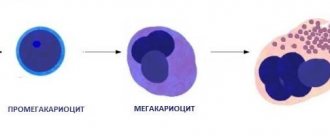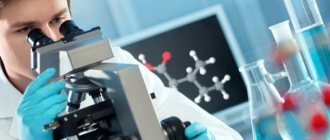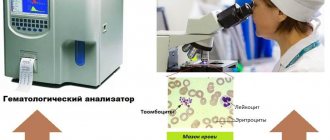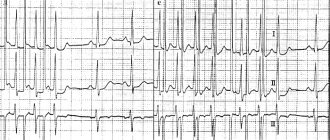Reasons for decreasing and increasing aggregation
Increased aggregation level or hyperaggregation is a condition in which blood flows slowly through the vessels and quickly clots. Provocateurs of such deviation can be:
- diabetes;
- hypertonic disease;
- cancer of the kidneys, gastrointestinal tract or blood;
- vascular atherosclerosis;
- leukemia;
- sepsis;
- lymphogranulomatosis;
- surgical excision of the spleen;
- menstruation in women.
Moderate platelet hyperaggregation during pregnancy is normal. This deviation occurs due to the need to nourish the placenta with blood. The value reaches its peak in the 3rd trimester of gestation.
A decrease in platelet aggregation occurs due to the following pathologies:
- thrombocytopathy;
- diseases of the hematopoietic system;
- use of antiplatelet agents;
- renal failure;
- dysfunction of the thyroid gland;
- anemia;
- alcohol abuse.
Platelet aggregation
Coagulogram
A coagulogram is a blood test to identify indicators of the hemostatic system, determining the ability of coagulation and possible deviations.
- A coagulogram is indicated: before planned operations in which there is a certain risk of bleeding;
- during pregnancy (every trimester, but in the presence of gestosis or fetoplacental insufficiency, the test can be performed more often);
- with varicose veins or increased thrombosis;
- patients with pathologies of the liver and cardiovascular system;
- patients with autoimmune diseases;
- in case of a blood clotting disorder caused by certain factors;
- while taking or before prescribing anticoagulants;
- to select the correct dose of ASA or drugs based on it;
- before prescribing oral contraceptives (the test is carried out once every 3 months);
- during hirudotherapy to prevent the formation of hemorrhages.
Our clinic performs:
Detailed coagulogram (cost 3,770 rubles)
Indications for analysis
Platelet aggregation is studied when:
- hemorrhagic disorders (increased bleeding);
- thrombophilia (coagulation disorder with an increased risk of thrombosis);
- severe atherosclerosis;
- diabetes mellitus;
- before performing surgical interventions;
- during pregnancy;
- when monitoring the effectiveness of anticoagulant and antiplatelet therapy.
Also, this study is important in the diagnosis of hereditary hemorrhagic thrombocytopathies.
Carrying out analysis and deciphering it
The study of platelet aggregation makes it possible to detect deviations from the norm and diagnose pathologies of the cardiovascular or hematopoietic systems. The procedure is necessary to monitor the dynamics of the course of certain diseases and control the treatment.
After collecting the biological material, special substances are added to the blood - inducers, which are similar in structure to the cells of the body that promote thrombus formation.
The inductor can be:
- adenosine diphosphate or ADP - platelet aggregation with ADP is considered the most common test method;
- adrenalin;
- ristomycin;
- arachidonic acid;
- collagen;
- serotonin.
The method for establishing aggregation is based on the passage of light waves through the blood plasma both before and after clotting. The following properties of the light wave are taken into account:
- The content of large platelets in the blood is increased
- character;
- form;
- speed.
All this happens in a machine called a platelet aggregation analyzer. The equipment is available in every Helix laboratory service.
The analysis is deciphered by a hematologist, and the indicator depends on the substance that was added to the test liquid and its concentration.
| Inductor | Aggregation rate (%) |
| AT with ADF | from 30.7 to 77.7 |
| Platelet aggregation with adrenaline | from 35 to 92.5 |
| AT with collagen | 46,4–93,1 |
| AT with ristomycin | 30–60 |
Platelet aggregation with arachidonic acid
Arachidonic acid is a natural aggregation agonist, and its action is mediated by the effects of prostaglandins G2 and H2, thromboxane A2, and includes activation of both phospholipase C with subsequent formation of second messengers, mobilization of intracellular calcium and expansion of the cell activation process, and phospholipase A2, which directly leads to release of endogenous arachidonic acid. Platelet aggregation with arachidonic acid occurs quite quickly, so the curve characterizing this process is often single-wave in nature.
To induce aggregation of blood platelets, arachidonic acid is used in concentrations of 10-3-10-4 mol. When working with arachidonic acid, it should be taken into account that in air this substance oxidizes very quickly.
An aggregation test with arachidonic acid is recommended in cases of using drugs that affect the aggregation reaction (for example, acetylsalicylic acid, penicillin, indomethacin, delagil, diuretics), which must be taken into account when assessing the research results.
Platelet aggregation is normal
As noted above, when setting the degree of platelet aggregation, several types of inducers of this process can be used. This is why platelet aggregation rates may differ depending on the nature of the reagent used. Imitation of blood platelet gluing is performed on glass with the addition of an inductor. These substances normally trigger blood clotting reactions in the human body. Of those used, only ristomycin (ristocein) has no biological analogues in the human body. Each inductor has its own norm.
Platelet aggregation with ADP
It is worth noting that to obtain a complete picture and for the purpose of accurate diagnosis, an analysis to determine platelet aggregation can be performed alternately with four inducers. ADP-induced platelet aggregation is often the first to occur. Normally, this indicator is within the limits 30,8–77,8%
. When platelet aggregation does not fit into the above values, doctors exclude the presence of the following types of diseases:
- myocardial infarction;
- ischemia;
- diabetes;
- arterial hypertension;
- thrombopathy of hereditary origin;
- cerebrovascular accident;
- thrombocytopathy in hemoblastosis.
Platelet aggregation with adrenaline
The study of platelet aggregation using adrenaline as an inducer is an informative diagnostic method. This method fully reflects the internal mechanism of activation of the blood vessel restoration process. The value taken as the norm is 35,0–92,5%
. An excess of the indicator indicates hyperaggregation, a decrease indicates hypoaggregation. Increased platelet aggregation is associated with a high concentration of platelets in the blood, pathology, stress, and taking a number of medications.
Platelet aggregation with ristomycin
When assessing how platelet aggregation occurs in the body, ristomycin helps to simultaneously identify von Willebrand syndrome. This disease is hereditary. The spontaneous aggregation of platelets that accompanies the disease is characterized by the appearance of periodic bleeding, which is similar to that occurring in hemophilia.
However, with this pathology, bleeding lasts longer, since the patient experiences a violation of all three parts of hemostasis at once. Doctors can also use an analysis with ristomycin when assessing the effectiveness of antiplatelet therapy and selecting the correct dosage of the drug. Normally, the values should be in the range 56–167%
.
Platelet aggregation with collagen
Often, doctors cannot determine exactly which stage of blood coagulation is impaired: platelet adhesion or aggregation - a collagen test helps determine this. If, with this type of study, doctors record an excess of the established standards, this indicates a failure of the adhesion process. Platelets cannot attach normally to the endothelium of damaged blood vessels, so bleeding does not stop for a long time.
The presence of pathology is judged by the discrepancy between the parameter values and the established norm. For the collagen test, platelet aggregation should be 46,5–93,2%
. Exceeding these values or decreasing the parameter indicates:
- Normal platelet count in children by age - table of values, reasons for deviations
- thrombopathy;
- hemoblastosis;
- disorders of the cardiovascular system.
Induced aggregation with ADP
Description Platelets play a significant role in human life: they prevent blood loss by connecting with each other on the wall of a damaged vessel. This process of platelets sticking together is called aggregation. It is important that this parameter does not deviate from the normal values, otherwise this is fraught with blood loss or the formation of a blood clot that can block the entire diameter of the vessel and lead to tissue death.
It is important that this parameter does not deviate from the normal values, otherwise this is fraught with blood loss or the formation of a blood clot that can block the entire diameter of the vessel and lead to tissue death.
Platelet aggregation: what is it?
The process of platelet aggregation into conglomerates is as follows: when a vessel is injured, platelets combine with von Willebrand factor and collagen of the subendothelial layer.
Aggregation of platelets with collagen causes activation of red blood cells, and they become sources of components that stimulate aggregation: thromboxane and serotonin. Platelet disaggregation is the reverse of aggregation.
Platelet aggregation is a protective function of the body, but it is also subject to the influence of pathological reactions.
On the one hand, platelet aggregation saves us from excess blood loss, which is important during surgical operations, major injuries and childbirth; on the other hand, hyperaggregation leads to the formation of a blood clot.
Blood clots are very dangerous: their movement through the circulatory system into the heart, brain or pulmonary artery can lead to rapid death. The study of platelet aggregation takes into account their ability to connect: with deviations above the norm, a heart attack or stroke may occur, below the norm - blood loss, anemia, exhaustion.
What is platelet aggregation in the blood? To determine the value of platelet aggregation, it is necessary to take a blood test from a vein into a test tube, and in this case, when there is no wound, it is necessary to create conditions for the combination of platelets into a conglomerate.
For this purpose, induced platelet aggregation is introduced in the laboratory.
Conditions become as close as possible to the body’s environment; substances identical in chemical composition to human substances that can cause thrombus formation are taken as an inducer of platelet aggregation.
Inductors can be:
- Serotonin.
- Collagen.
- Adrenalin.
- Arachidonic acid.
- Adenosine diphosphate (ADP).
The way to measure platelet aggregation is to pass light through the blood plasma.
The difference between the light density of plasma before blood clotting and after clot formation is the aggregation activity of platelets. Additionally, the rate of platelet aggregation in 1 minute, the shape and type of waves are determined.
Spontaneous platelet aggregation is calculated without the use of an inducer.
Degree of platelet aggregation:
- norm with ADF – 30.7 – 77.7%
- with collagen – 46.4 – 93.1%
- with adrenaline – 35 – 92.5%
Preparing for the test
A reliable assessment of the result can be obtained if the following conditions are met: Do not eat 12 hours before the test. The day before blood sampling, do not perform physical activity or experience emotional turmoil.
7 days before the test, stop taking a number of medications (if this is not possible, then inform the nurse).
The day before the test, avoid alcohol, smoking, garlic and coffee. Come to donate blood healthy, without inflammation in the body.
Deviation from the norm
A decrease in platelet aggregation can occur for the following reasons:
- The presence of thrombocytopathy.
- Treatment with antiplatelet drugs.
Thrombocytopathy is a disease in which platelet functions (clotting, thrombus formation) are impaired. The disease manifests itself by the presence of bruises and bleeding, which subsequently leads to anemia.
If platelet aggregation is reduced, then drug treatment is prescribed, which should be carried out by a qualified specialist.
Increased platelet aggregation can occur with:
- Hypertension.
- Atherosclerosis of joints.
- Stroke and heart attack.
- Diabetes mellitus.
- Thrombosis.
If platelet aggregation is increased, then conservative therapy with the use of antiplatelet agents cannot be avoided. Be sure to visit a doctor to get tested and receive treatment recommendations.
During pregnancy, deviations from normal platelet aggregation values are possible.
A reduced level indicates the danger of bleeding, an increased level indicates toxicosis as a result of loss of fluid from the body and is fraught with miscarriage.
During pregnancy, the degree of platelet aggregation: the norm is 30-60% for any inducer. A platelet aggregation test is prescribed in cases of complicated pregnancy, poor medical history, and before planned conception.
Normal platelet count in blood
To know the state of platelet levels, you need to have an idea of their normal level.
| Age | Indicator, x 10^9/l |
| Newborn | 100-420 |
| up to 1 year | 160-320 |
| from 1 year to 4 years | 150-300 |
| from 15 to 18 years old | 180-340 |
| Men over 18 years old | 180-400 |
| Women over 18 years old | 150-380 |
If we talk about the aggregation rate, then it is 25-75%. In this case, the process of platelet gluing occurs well and does not pose any health hazard.









